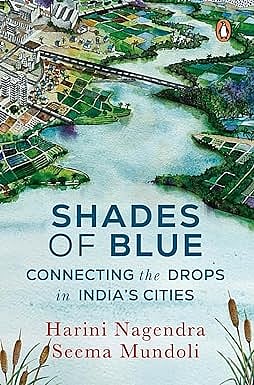Rivers of Life

Both the authors of this clear-as-spring-water book teach sustainability at the Azim Premji University in Bengaluru, and have collaborated before for their well-received book, Cities and Canopies (2019). In this offering they examine our (especially us city-dwellers) relationship with that elixir of life: water, occasionally diving deep into the past to show us what was, and what is now, and what is likely to be.
The cities covered in this book (most major cities around the world are located near water sources) include Delhi, Kolkata, Mumbai, Udaipur, Chennai, Bengaluru, Guwahati—as also the Lakshadweep archipelago. For example, they tell us the story of how Delhi, Chennai and Bengaluru paid the price for building over their natural water bodies and floodplains in the name of development—which often ended up in one major catastrophe after another.
Interwoven are chapters dealing with other aspects of water and our relationship with it: the spreading of pathogens, the beasties that some of us claim live in our rivers and lakes and legends around them, the ill-conceived plans to interlink major rivers, the muck we clog our water-bodies with, the sacredness with which we regard them (in spite of dumping sewage and all our sins in them), the effect of climate change on them—usually furious flash-floods, and the livelihoods of the millions who depend on them (via fishing and transport), the wildlife they harbour—some of which are in really deep waters et al. Big dams for example, so hugely beloved of governments, only end up throttling rivers, silting them to the hilt, besides displacing thousands living in adjoining areas (and forests) condemned to being flooded.
2026 New Year Issue
Essays by Shashi Tharoor, Sumana Roy, Ram Madhav, Swapan Dasgupta, Carlo Pizzati, Manjari Chaturvedi, TCA Raghavan, Vinita Dawra Nangia, Rami Niranjan Desai, Shylashri Shankar, Roderick Matthews, Suvir Saran
Some of the characters include spies, city-planners, and indigenous people who have lived by these rivers, lakes and coasts for generations and whose wisdom and knowledge is usually ignored.
And no, it’s not a doom-and-gloom book by any yardstick. Yes, there are awful things we are doing to our water bodies, which bode ill for us in the future and make for depressing reading, but equally there is an army of people out there striving to turn things around and who have succeeded in doing so.
What is fascinating and I suspect little known is the way water was ‘managed’, stored and treated, and brought to, and distributed in cities in the past. The authors have dug deep into the wells of history. They write of how kings and colonials dealt with the issue of providing adequate drinking water to their realms, as also about some of the hair brained as well as very pragmatic schemes they devised. Some of those old ways perhaps need to be replicated today, at a time when alas, the hair-brained plans seem to be proliferating.
And the authors are not shy of pointing this out. They do suggest that the book ought to be read as a ‘fun’ book, taken down in one big gulp, or chapter by chapter, sip-by-sip which is how I read it. I’m not too sure about the fun part of it, but the prose is straightforward, sparkling and crystal clear. After every chapter my eyes opened a little wider and I looked at the copper-flask of water on my table, with just a little more respect.
The book is meticulously referenced and ought to be on the shelves of every school and college, and anyone who reaches for a glass of water every now and then! It is certainly more refreshing than any dusty-musty academic tome on the subject, and could probably teach you much more.

